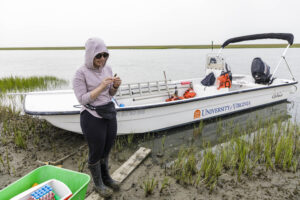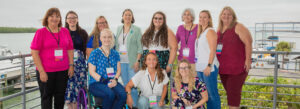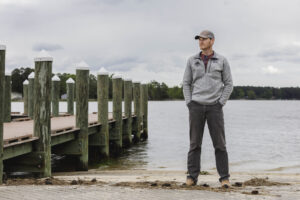Bridge website redesign puts teachers at the helm
Like the bridge of a ship—the nautical command center—the Bridge website allows teachers to navigate a wealth of marine science classroom resources. Now, after two decades, the website has an updated look and new features to match the first-class tools it houses.
“We wanted people to see it as relevant, and it’s hard to impress upon people that something is high-quality information if it looks old and outdated,” says Celia Cackowski, a Marine Education Specialist in the Marine Advisory Program at the Virginia Institute of Marine Science (VIMS), who manages the website.
The redesigned site now highlights a wider variety of the resources and includes a more intuitive search function. When the Bridge first launched in 1998, it might have been the only website of its kind. Twenty years later, the way people use the web has changed. For example, search engines today allow people to find what they were looking for even without using exact phrasing.
This was one of the biggest challenges for the Bridge.
“People would come up to us at conferences and say, ‘I really wish you guys had a resource on microplastics,’ and I’d say, ‘We have like 20 resources on microplastics,’ and they would say they couldn’t find them,” Cackowski explains. “It was because we were indexing them in a way that wasn’t intuitive for teachers. Now we have these broader topics, so if someone misses the exact keyword, they can still get the resource to come up. This is going to be much more intuitive.”
The upgrades also include an expanded infographic library—another feature requested by many educators. Not only are infographics a visual way for students to learn about complex topics, Cackowski says the infographics are useful for incorporating ocean science concepts into multiple classroom subjects.
The Bridge is the official resource clearinghouse for the Sea Grant Educators Network and features more than 1,300 resources for teaching ocean science that are approved by teachers and scientists. More than 60 classroom-ready lesson plans are available through the DATA series, which allow students to work with real datasets through grade-appropriate activities. Last year, the Bridge averaged around 11,000 page visits each month from viewers representing 201 countries.
“We have these broader topics, so if someone misses the exact keyword, they can still get the resource to come up. This is going to be much more intuitive.”
“Our goals with our teaching programs are to deliver ocean science content to teachers so they can incorporate that into any science subject at any grade level,” says Lisa Lawrence, the Marine Education Program Leader for Marine Advisory Program at VIMS.
Now that the new website design is complete, Bridge staff plan to expand the resources available, including new lesson plans, a video library, and information about marine science careers. Cackowski also plans to expand the Bridge’s social media presence.
Until then, educators can continue to use the hundreds of resources already published on the site—and maybe spend a little less time searching for them.
Visit the Bridge website here.
Takeaways:
- The Bridge website provides ocean science resources for educators that incorporate accurate science in a classroom-ready format.
- The Bridge’s improved search feature will make the website’s resources easier to find.
- The new design and features will help the Bridge stay on the forefront of ocean science education.
Photos and video by Aileen Devlin | Virginia Sea Grant
Story by Madeleine Jepsen | Virginia Sea Grant
Published March 9, 2019.
“Our goals with our teaching programs are to deliver ocean science content to teachers so they can incorporate that into any science subject at any grade level,” says Lisa Lawrence.






